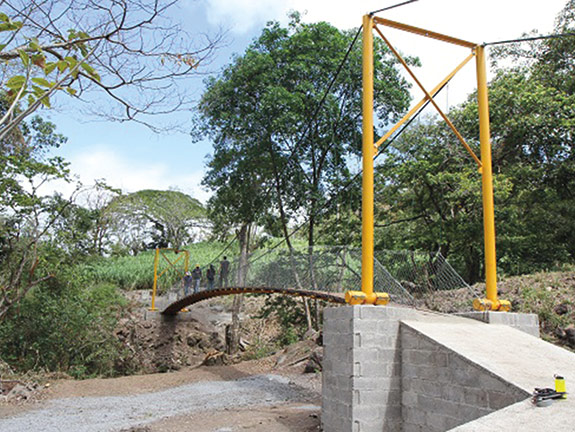Jaclyn Phillips ’10 spent her first two days in Nicaragua twenty feet in the air, atop a scaffolding she helped build.
In a remote village as part of a volunteer team, Phillips was helping build a 115-foot suspension footbridge across the El LimónRiver, which floods during the rainy season from June through November. “The village is very remote,” says Phillips. “The villagers have to cross two rivers to get to school, health care, and jobs. Farmers need to cross them to sell their crops.”
Whether high in the air stringing crossbeams or sleeping in a tent in a schoolyard, Phillips relished her two weeks there, from the challenge of figuring out how to lift, or trip, the two 900-pound bridge towers by hand to the experience of living and working among the Nicaraguan villagers.

Growing up in the Tri-Cities, Phillips loved math and science, but it wasn’t until she attended a Young Women in Science program one weekend that she found her calling. One of the hands-on activities involved assembling a building using pre-cut pieces of paper and guided by specifications and building codes like hallway width. She had to get all the pieces to fit. It was a huge, challenging puzzle. “It was problem solving, too,” she says. “When I walked out that day I knew I wanted to be an engineer.”
At WSU she focused on civil engineering and signed up for Engineers Without Borders. During her senior year, Phillips traveled to Concepción, Chile, where WSU professor J. Daniel Dolan led WSU and Chilean students in developing plans to clean up Lake Las Tres Pascualas. “It was in a great location,” says Phillips. “It had a lot of potential as far as parks.” But 60 homes had sewer systems discharging into the 13-acre lake and the surrounding neighborhoods produced additional contamination. The municipality and a private university planned to purchase and tear down the houses and turn the lake into a park, using the students’ study to determine how to do so.
During her summers, Phillips interned for Kiewit, a major construction company with projects throughout the United States and Canada. Her internship kept her closer to home, rehabilitating the 1961 Hood Canal Bridge. The project, among other things, replaced the east half of the floating structure, widened part of the deck, replaced pontoons, and built new bridge approaches both on the Olympic Peninsula and Port Gamble sides. “The internship was great. It was really just one big interview,” says Phillips. “I was offered a job on my second-to-last day.”
Now she’s a registered professional engineer working for Kiewit and building segments for the Honolulu Transit Kamehameha Guideway in Hawaii. The 20-mile elevated rail line will connect the city center of Honolulu to neighborhoods in two directions.
Phillips moved to Hawaii when the project started three years ago. “It’s great, even though I’m three thousand miles from home,” she says. “I can’t snowboard right now. But the outdoor life here offers a lot.”
In July 2013, her company announced a search for volunteers for a Bridges to Prosperity project in Nicaragua. “The second I heard about this, I knew this was a trip for me.” She submitted her application and was thrilled to be one of nine employees selected for the two week trip last February to Cinta Verde, an agricultural village of about 300 people. While volunteers from another company designed the plans for the bridge, the villagers provided the labor, and working alongside them, “we provided the expertise,” she says.
The volunteers could have done the entire project themselves, but bringing the villagers in to work helped them understand how it was built and how it might be repaired. “We needed to make this bridge their bridge,” says Phillips. The men helped build and the women provided everyone with breakfast, lunch, and dinner. “We had a lot of rice and beans,” says Phillips. “Though one day they made us tamales. That was a treat.”
Lifting up and setting the bridge’s two towers on their piers became her biggest challenge. They managed to do it with ropes, pulleys, and the collective strength of the volunteers and villagers. “We jumped up on the scaffolding to help trip the towers. We did it all by hand,” she says. “I didn’t learn until later that it was the first time it had been done like that.”
Back home in Hawaii, Phillips continues helping Kiewit finish its 20-mile rail transit project. But she’s still looking to volunteer her engineering skills. “It’s not the last time I’ll do something like this.”
